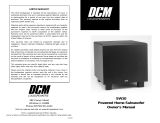Glossary
Active: Uses electrical power.
Amplifier: An electronic device that increases the cur-
rent of a signal, providing power to the loudspeakers (i.e.
power amplifier, integrated amplifier, receiver).
Bass: The range of audio frequencies below 160Hz,
characterized by low pitch.
Crossover: An electronic circuit that divides an audio
signal into different frequency ranges.
Distortion: Any deviation from the original signal,
caused by any type of equipment.
Driver: The moving part of a loudspeaker which radiates
energy.
Dynamics: Variations in loudness of sound.
Efficiency: See sensitivity.
Frequency: A rate of vibration which corresponds to
musical pitch in the audio band, expressed in Hertz (Hz).
Full Range: A signal encompassing the entire frequen-
cy spectrum, not filtered above or below
a certain frequency.
Hertz (Hz): A unit of frequency equal to one cycle per
second, used to measure the frequency of a signal or
sound.
High-Pass Filter: A filter that passes only frequencies
above a certain lower limit; electronically removes low
frequencies from a full range signal.
Impedance: A measure of the total opposition to current
flow in an alternating current circuit, described in ohms.
In Phase: The polarity of an audio signal when connect-
ed as follows: (+) to (+) and (-) to (-).
Integrated Amplifier: Has preamplifier and amplifier
built into one chassis.
Interconnect Cable: A length of shielded wire with plugs
at both ends for feeding signals from
one electronic device to another.
LFE: Low Frequency Effects; an RCA output for connec-
tion to a subwoofer.
Line-Level Connection: Low level RCA/phono type
connection.
Load: A term used to describe the impedance which a
speaker presents to an amplifier.
Low-Pass Filter: A filter that passes only frequencies
below a certain upper limit; electronically removes high
frequencies from a full range signal.
Main Speakers: Front L & R channel speakers, some-
times referred to as satellites.
Main-in: A line-level RCA input on the back of a receiv-
er, integrated amplifier or power amplifier.
Midrange: The frequency span of the middle of the
audio range, roughly 160Hz - 3OOOHz. Also used to
describe the driver which reproduces these frequencies.
Ohm: A unit of electrical resistance; that which opposes
an electric current in a conductor. In audio, a measure
of the load presented by a device to an electrical source.
Out-of-Phase: The polarity of an audio signal when con-
nected as follows: (+) to (-) and (-) to (+).
Passive: Uses no electrical power.
Phase: An expression of the relative polarities of two
identical signals.
Power Handling: The ability of a loudspeaker to operate
without distortion when given varying amounts of
wattage.
Preamplifier: An electronic device that selects sources
and passes line-level signal to amplifier.
Pre-Out: A line-level RCA output on the back of a receiv-
er, integrated amplifier or preamplifier.
Receiver: Has preamplifier, amplifier and tuner built into
one chassis.
Satellite: Front L & R speakers when used with a sub-
woofer. Referred to as main speakers.
Sensitivity (same as efficiency): A measure of how
much of the input electrical energy is converted into
sound energy, measured in decibels.
Signal: The series of continually changing electrical volt-
ages that correspond to variations in the loudness of the
original sound.
Speaker-Level Connection: The connection between a
loudspeaker and an amplifier.
Subwoofer: A driver designed to operate over the low
bass portion of the audio range. Also refers to a system
consisting of a woofer and its enclosure which are phys-
ically separate from the upper range loudspeakers.
Surround Speakers: Speakers located in the side or
rear for surround channel effects.
Treble: The upper part of the frequency spectrum, con-
sisting of frequencies above about 1300Hz.
Tweeter: A small driver designed to reproduce high fre-
quencies.
Watt: A measure of electrical power, combining the volt-
age with the electrical current required to drive the loud-
speaker.
Weight: Low frequencies below 50Hz.
Woofer: A driver designed to operate over the bass-
portion of the audio range.






















